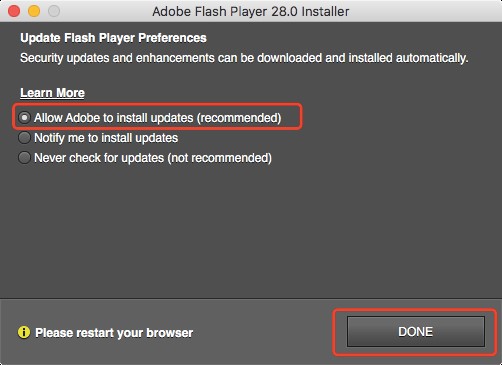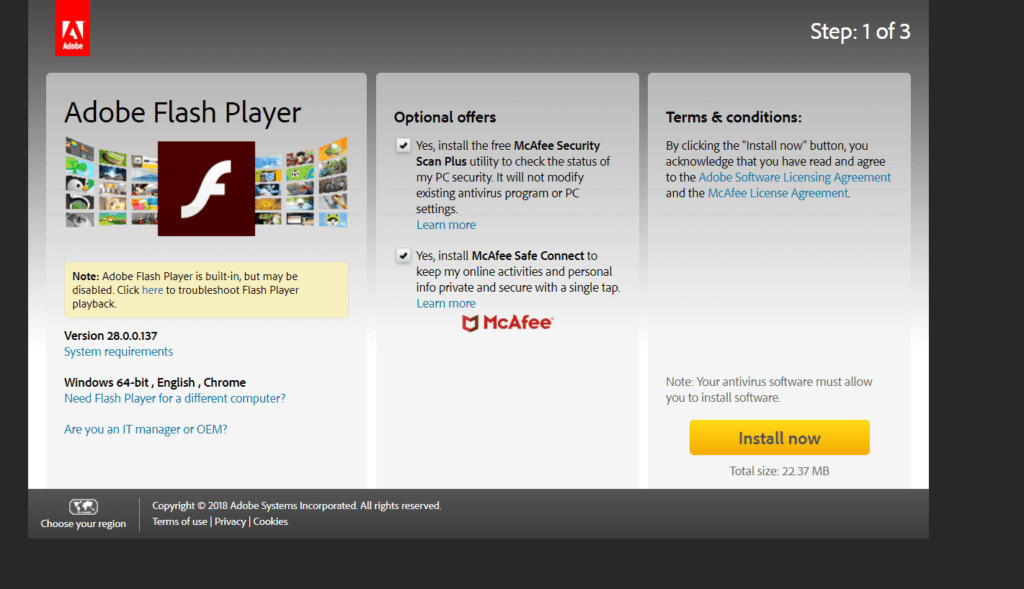
The best alternative is to uninstall Flash from your system and download Google Chrome as it has Flash build into it and you're not vulnerable unless you're browsing in Chrome. If Safari is your main browser, as mine is, then you need to open Safari Preferences, go to Advanced and click the checkbox for 'Show Develop menu in menu bar'. Mac users interested in Flash player os x 10.5.8 generally download: Flash Player 26.0 Free Flash Player 10.1 is Adobe's last version of the popular Flash player. About Adobe Flash Player for Mac The Adobe Flash Player is a widely distributed proprietary multimedia and application player created by Macromedia and now developed and distributed.
Stage 3D Accelerated Graphics Rendering (Player & AIR desktop + AIR for TV)
Stage 3D is a new architecture for hardware accelerated graphics rendering developed that provides a set of low-level APIs that enable advanced 2D and 3D rendering capabilities across screens and devices (desktop, mobile, and TV). Using Stage 3D, app and framework developers can now access high performance GPU hardware acceleration, enabling the creation of new classes of rich, interactive experiences. Note: Stage 3D for mobile versions of Flash Player & AIR will be enabled in a future releaseEnter your state here.
Flash Access Content Protection Support for Mobile
Flash Access content protection support is now available on mobile devices including Android powered smartphones and tablets. In addition, content protection is now supported on tablet devices powered by the BlackBerry® Tablet OS. Note: Flash Access for iOS is not supported at this time.
Flash Access Content Protection Enhancements
New Flash Access content protection features include key rotation support, V3 license chaining, domain support and enhanced output protection and device filtering.
Protected HTTP Dynamic Streaming (HDS)
Protected HTTP Dynamic Streaming (HDS) provides protection for streaming video across screens while eliminating the deployment complexity of a license server.
NetStream.dispose()
Similar to NetStream.close() except that it also clears up the last frame held up by NetStream to be displayed on the Video object. Use this instead of NetStream.close() if the NetStream is to be re-used for other streams later. It enforces garbage collection of the video frame and related decompressor objects. The video object will display a blank frame after the use of this method.
H.264/AVC Software Encoding for Cameras (desktop)
Free Adobe Flash Player Free Download For Mac Os X
Stream high-quality video from your computer's camera with higher compression efficiency and industry stanard support, enabling both immersive real-time communications such as video chat/conferencing and live video broadcasts.
JPEG-XR support
Flash Player and AIR now include support for the JPEG-XR advanced image compression standard (International Standard ISO/IEC 29199-2). The computationally lightweight JPEG-XR format provides more efficient compression than JPEG, enables both lossy and lossless compression support, and adds support for alpha channel transparency.

Enhanced high resolution bitmap support
BitmapData objects are no longer limited to a maximum resolution of 16 megapixels (16,777,215 pixels), and maximum bitmap width/height is no longer limited to 8,191 pixels, enabling the development of apps that utilize very large bitmaps.
High efficiency SWF compression support
Developers can now take advantage of LZMA compression for their SWF files. LZMA compression can reduce SWF size by up to 40%, enabling users to benefit from richer experiences with shorter download times and reduced bandwidth consumption.

G.711 Audio Compression for Telephony
Support interoperability with legacy phone systems via the Flash Media Gateway (FMG) and other third-party clients (through the open RTMP protocol) without the need for transcoding.
Native JSON (JavaScript Object Notation) Support
Allows ActionScript developers to take advantage of high performance native parsing and generation of JSON-formatted data.
Garbage Collection Advice
Provides smoother, more responsive user experiences by allowing developers to provide hints to optimize garbage collection scheduling.
Cubic Bezier Curves
The cubicCurveTo drawing API allows developers to easily create complex cubic Beziers without requiring custom ActionScript code.
Secure Random Number Generator
Developers can now take advantage of cryptographically secure random number generation to build more secure algorithms and protocols.
Socket Progress Events
Improve management of data transfer using the Socket class by providing a new property to determine the number of bytes remaining in the write buffer and a new event for when data is being sent to the network layer. Using these new APIs, developers can build applications such as file transfer utilities that monitor socket progress and provide responsive feedback.
DisplayObjectContainer.removeChildren and MovieClip.isPlaying
DisplayObjectContainer now implements a removeChildren API allowing developers to quickly remove all of a container's children using a single API call. A new MovieClip.isPlaying property returns the MovieClip's current playing state.
New Features in Flash Player
Native 64-bit Support (Flash Player desktop) — Take advantage of native support for 64-bit operating systems and 64-bit web browsers on Linux, Mac OS, and Windows.
Asynchronous Bitmap Decoding (new for Flash Player) — Improve app responsiveness and deliver smoother animation by decoding images on initial load instead of on demand. Images are cached as needed.
TLS Secure Sockets Support (new for Flash Player) — Enables secure communications for client/server applications.
What's New:
Adobe Flash Player Free Download For Mac Os Sierra
In today's release, we've updated Flash Player with critical security and functional bug fixes. We recommend all customers upgrade to this version.
For those organizations that use the Extended Support Release (ESR), please note that we have incremented the ESR from version 13 to version 18 with today's update.
Current Flash Player users who have enrolled in the 'Allow Adobe to install updates (recommended)' update mechanism will be automatically updated to the latest version of Flash Player over the next 24 hours.
Users who have selected 'Notify me to install updates' will receive an update notification dialog within 7 days from today. Please note that Windows users will need to restart their system or log out and in to activate the update notification dialog.
Flash Player can always be downloaded and installed by simply visiting https://get.adobe.com/flashplayer
Customers using Google Chrome or Windows 8.x Internet Explorer will receive the update through the Google and Microsoft update mechanisms.
Recent Adobe Flash Player for Mac news
- 2543 votesAdobe Flash Player is a cross-platform browser-based application runtime that delivers uncompromised viewing of expressive applications, content, and videos across screens and browsers.
- Freeware
- Windows
- 54 votesAdobe Flash Player is a cross-platform browser-based application runtime that delivers uncompromised viewing of expressive applications, content, and videos across screens and browsers.
- Freeware
- Linux
These instructions are NOT applicable to Flash Player included with Google Chrome. Visit the Flash Player Help page for instructions on enabling (or disabling) Flash Player in various browsers.
If you use Windows, see Uninstall Flash Player | Windows.
If Flash Player is installed on your computer, the following box displays the version of Flash Player and your operating system. If Flash Player is not installed, an error message appears.
If your Flash Player installation was not successful, use the following solution to reinstall.
Click the Apple icon and choose About This Mac.
The Mac OS version appears in the About This Mac dialog.
2. Run the uninstaller applicable to your Mac OS version
- Run the uninstaller on Mac OS X 10.4 and later, including macOS
Note:
Beginning with Flash Player 11.5, uninstalling the Flash Player resets the AutoUpdateDisable and SilentAutoUpdateEnable settings in mms.cfg to their default values:
- AutoUpdateDisable=0
- SilentAutoUpdateEnable=0
If you are running the Flash Player uninstaller as part of your deployment process, redeploy any custom changes to either AutoUpdateDisable or SilentAutoUpdateEnable.
Run the uninstaller on Mac OS X 10.4 and later, including macOS
Download the Adobe Flash Player uninstaller:
- Mac OS X, version 10.6 and later: uninstall_flash_player_osx.dmg
- Mac OS X, version 10.4 and 10.5: uninstall_flash_player_osx.dmg
The uninstaller is downloaded to the Downloads folder of your browser by default.
In Safari, choose Window > Downloads.
If you are using Mac OS X 10.7 (Lion), click the Downloads icon displayed on the browser.
To open the uninstaller, double-click it in the Downloads window.
Note: If the Flash Player installer window does not appear, choose Go > Desktop in the Finder. Scroll down to the Devices section and click Uninstall Flash Player.
To run the uninstaller, double-click the Uninstaller icon in the window. If you see a message asking if you want to open the uninstaller file, click Open.
- Bookmark or print this page so that you can use the rest of these instructions after you close your browser.
To close all browsers, either click the browser name in the Uninstaller dialog, or close each browser manually and then click Retry.
Note: Do not click Quit in the Uninstaller window. It stops the uninstallation process.
After you close the browsers, the uninstaller continues automatically until the uninstallation is complete. When you see the message notifying you that the uninstallation succeeded, click Done.
Delete the following directories:
- <home directory>/Library/Preferences/Macromedia/Flash Player
- <home directory>/Library/Caches/Adobe/Flash Player
Download the Adobe Flash Player uninstaller:
- Mac OS X, version 10.3 and earlier: uninstall_flash_player_osx_10.2.dmg (1.3 MB) (updated 05/27/08)
Choose Window > Downloads to view the downloaded uninstaller.
Save the uninstaller file in a convenient location.
To open the uninstaller, double-click it in the Downloads window.
To run the uninstaller, double-click the Uninstaller icon in the window. If requested, enter your computer user name and password and click OK.
Bookmark or print this page so that you can use the rest of these instructions after you close your browser. Close all browsers and other applications that use Flash Player, including instant messaging applications, SWF files, and projectors (EXE files that play SWF files). Otherwise, the uninstaller cannot finish (even though it appears to finish).
Once the uninstaller finishes, the window closes automatically.
You can verify that uninstallation is complete by following these steps:
Flash Player Download Free Mac
Open your browser and check the status of Flash Player.